The 14 Best LED Light Therapy Face Masks for At-Home Treatments, According to Beauty Editors and Experts
Tested and approved tools for treating fine lines, rosacea, hyperpigmentation, and acne.

Julia Marzovilla
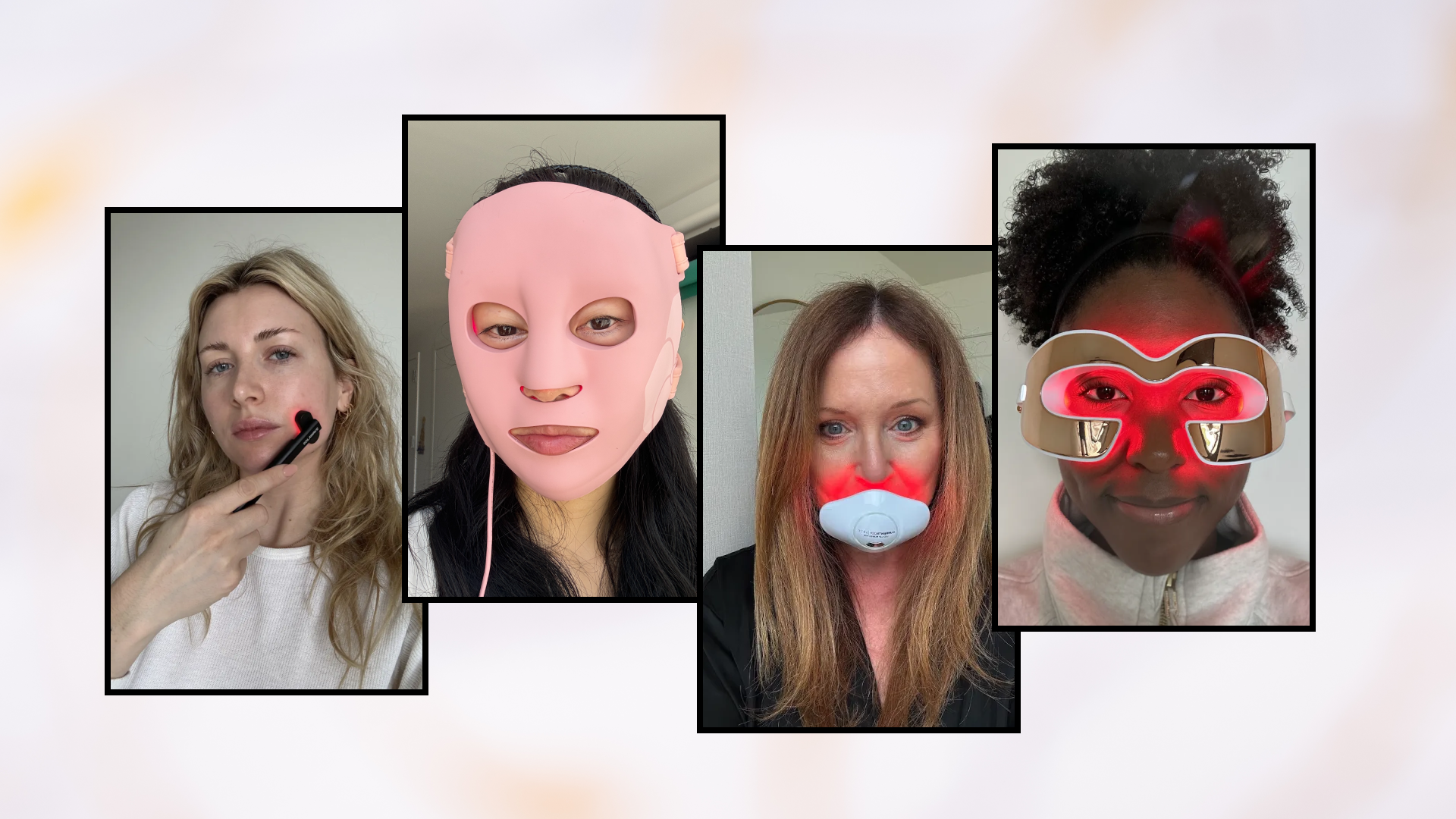
I try beauty products for a living—the good, the bad, the life-changing. The most transformative ones I've tested are the beauty tools, most of which can replicate (or at least prolong) the results of a professional skincare treatment. At the top of the must-have list? The best at-home LED face masks, a.k.a light therapy masks. These anti-inflammatory, fine line-reducing, acne-fighting light therapy treatments—which were once only available under the practiced hand of a dermatologist—leverage blue light, red light, yellow light, green light, and on occasion, white light to target various skin concerns in the short-term (an at-home session takes about 10 minutes) and the long-term.
The masks are an investment, sure. But if you plan on using one regularly, it's well worth it. But finding the right device to suit your skin's needs can feel slightly overwhelming. That's why Marie Claire talked to leading dermatologists and tested the top-rated and top-recommended beauty devices on the market to give you our expert-approved recommendations. Ahead, get insight from Tanuj Nakra, MD, FACS, a double board-certified facial and ophthalmic plastic surgeon, and Erica Marie Gatt, esthetician and founder of EM Skin Studio in Hermosa Beach, California.
Keep scrolling to discover the 14 beset LED light therapy face masks that are worth a spot in your skincare routine.
The Best LED Light Therapy Masks
- The Best Overall At-Home LED Mask: Dr. Dennis Gross Skincare DRx SpectraLite FaceWare Pro
- Best Cooling At-Home LED Mask: Shark Cryoglow™ Red Blue & Infrared Iqled Face Mask & Under Eye Cooling
- Best Comfortable At-Home LED Mask: Omnilux Contour Face
- The Best At-Home LED Mask for Redness: MZ Skin LightMAX Supercharged LED Mask 2.0
- The Best At-Home LED Mask for Acne: LightStim for Acne
- The Best Luxury At-Home LED Mask: Shani Darden by Déesse PRO LED Light Mask
The Best LED Light Therapy Masks, By The Numbers
Device Name | FDA-Cleared? | Light Modes | Recommended Use | Header Cell - Column 4 |
|---|---|---|---|---|
Yes | Red, Blue | Three minutes per day | Row 0 - Cell 4 | |
Shark Cryoglow™ Red Blue & Infrared Iqled Face Mask & Under Eye Cooling | Yes | Red, Blue, and Infrared | 4-8 minutes (depending on the treatment), once per day. | Row 1 - Cell 4 |
Yes | Red and Near-Infrared | 10 minutes, 3-5 times per week | Row 2 - Cell 4 | |
Yes | Red, Blue, and Infrared | 10 minutes, four times per week | Row 3 - Cell 4 | |
Yes | Blue, Red | No more than three minutes per area on the face daily | Row 4 - Cell 4 | |
Yes | Red, Blue, Near-Infrared | 10 minutes, 4-5 times per week | Row 5 - Cell 4 | |
Dr. Dennis Gross Skincare DRx SpectraLite LED EyeCare Max Pro | Yes | Red | Three minutes, daily | Row 6 - Cell 4 |
No | Full-spectrum lights | The pre-programed treatments last for two minutes, all of which can be found in the complimentary phone app, daily | Row 7 - Cell 4 | |
Yes | Red and Near-Infrared | 10 minutes, 3-5x per week. | Row 8 - Cell 4 | |
Yes | Red and Blue | Nine minutes, daily. | Row 9 - Cell 4 | |
Yes | Red | No more than three minutes per area of the face, daily. | Row 10 - Cell 4 | |
No | Red and Near-Infrared | 10-20 minutes, 3-5 times per week. | Row 11 - Cell 4 | |
Yes | Red, Near-Infrared, Amber | Three minutes, daily. | Row 12 - Cell 4 | |
Yes | Red and Near-Infrared | 10 minutes, 3-5 minutes per week. | Row 13 - Cell 4 |
Shop The Best At-Home LED Therapy Masks
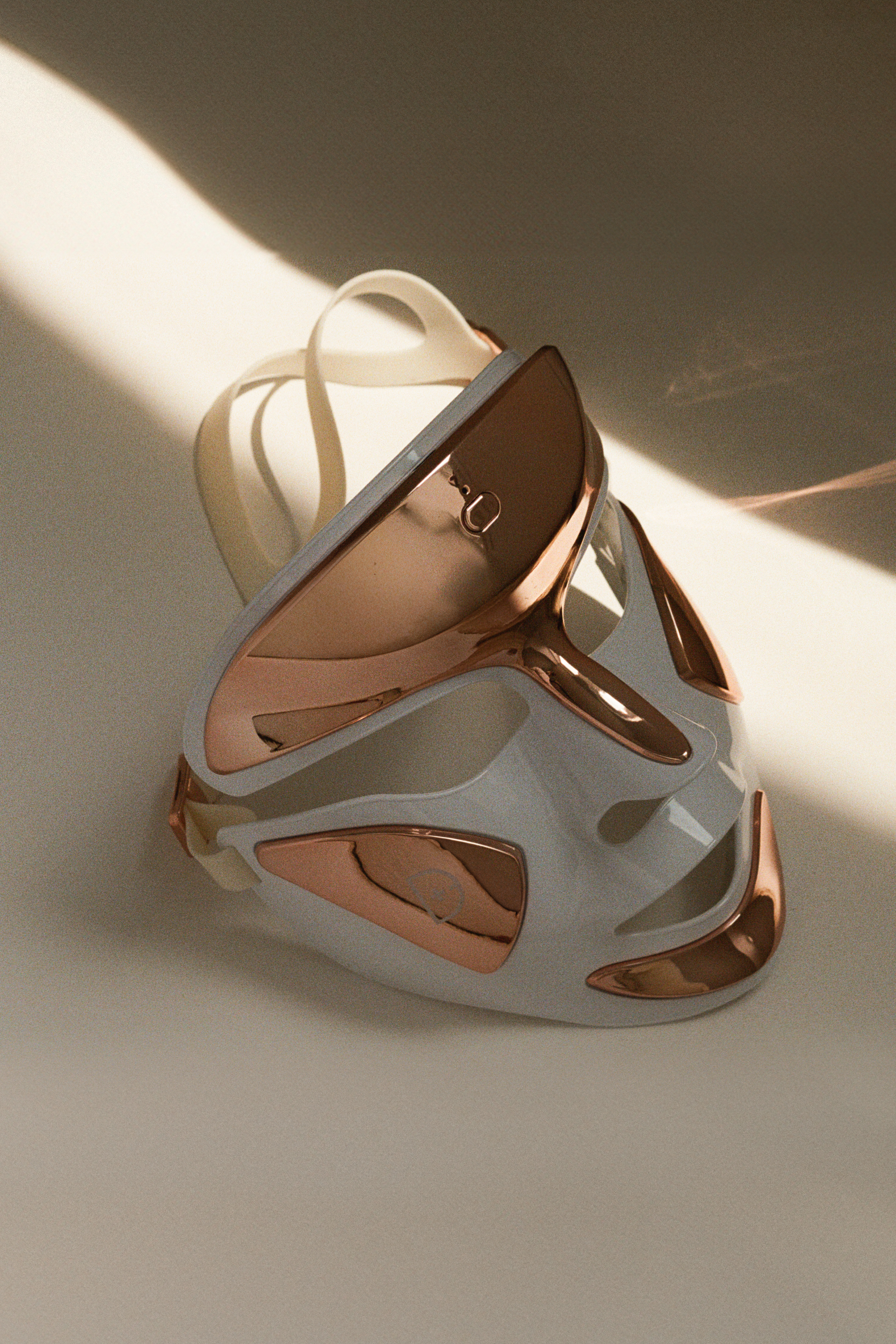
This best-selling and FDA-cleared LED mask from Dr. Dennis Gross Skincare is a favorite of Dr. Nakra because it "is well designed, has extensive LED arrays and covers the bases with the right frequencies," he says. It has a "medium" to "high" strength irradiance, which is ideal for those looking for real results." It combines red and blue lights for two different treatments that tackle redness and acne. Each three-minute session, which you can do hands-free thanks to the secure silicone head strap, promises brighter, more even skin over time.
FDA-Cleared: Yes
Light Modes: Red and blue
Usage: Three minutes per day
What I Love: Reviewers found it easy to use; has dual-action lights (red and blue); professional grade
What I Don't: Some reviewers found it bulky
Review For MC: "I've had this LED mask for about a year now, but I really put it to use during the 12-week testing period. First, a little about my skin type. I'm prone to hormonal acne, but have dry, dehydrated skin beyond that. I struggle mostly with redness, acne scarring from said breakouts, and, as of recently, some fine lines around my forehead and eyes. Over the three months that I tested this mask, I found it to be an easy addition to my evening routine. I would use it after cleansing my face and before applying the rest of my skincare products for the best results. Over the testing period, I noticed that my skin looked and felt increasingly glowy over time, and that the redness in my skin had also reduced. I saw the least amount of improvement in my fine lines, but I expect to see changes there as I continue to use the mask." — Julia Marzovilla, Fashion E-Commerce Editor

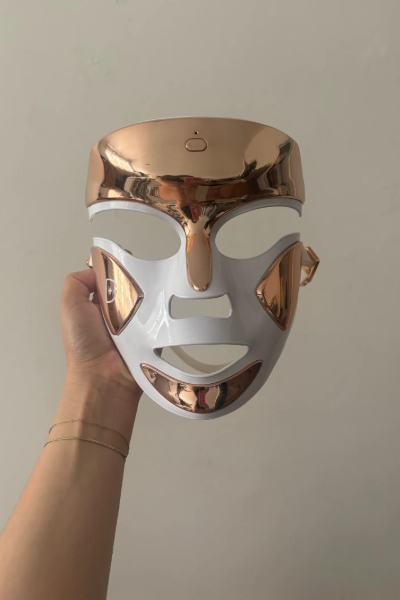

Shark's new CryoGlow Under-Eye Cooling + LED Anti-Aging & Skin Clearing Face Mask introduces a refreshing sensation to the LED mask category: undereye cooling. Now we can add "puffines" to the laundry list of other skin concerns it claims to help resolve alongside fine lines, wrinkles, and acne. It does so with a combination of red, blue, and deep infrared LED lights and four different targeted treatment plans. Each plan runs for less than 10 minutes, making it an easy, hands-free addition to any skin-lover's morning routine—and it has the seal of approval from Marie Claire's Beauty Director, Hannah Baxter.
FDA-Cleared: Yes
Light Modes: Red, Blue, and Infrared
Usage: 4-8 minutes (depending on the treatment), once per day.
What I Love: Has under-eye cooling pads; can be used every day; has four treatment plans for easy use; has an adjustable head strap; lightweight despite its size.
What I Don't: It's chunkier than other masks.
Review for MC: "I'll say here and now: no LED mask is worth it unless you're actually willing to use it consistently. That means it better be comfortable, and better yet, wearable while you're doing something else, like answering emails. This device easily manages that while also providing an added bonus with the under-eye cooling pads. Such a great idea, especially for someone like me who wakes up to puffiness every day. I struggle with hyperpigmentation, especially in the summer, so I use this mask more as a maintenance treatment after in-office lasers or red light therapy (where you'll get the most impressive results). I also appreciate that it has a blue light option to fight acne-causing bacteria. More bang for your buck is always appreciated." — Hannah Baxter, Beauty Director
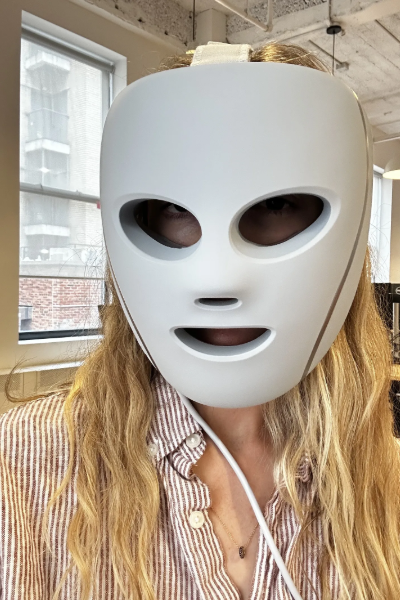
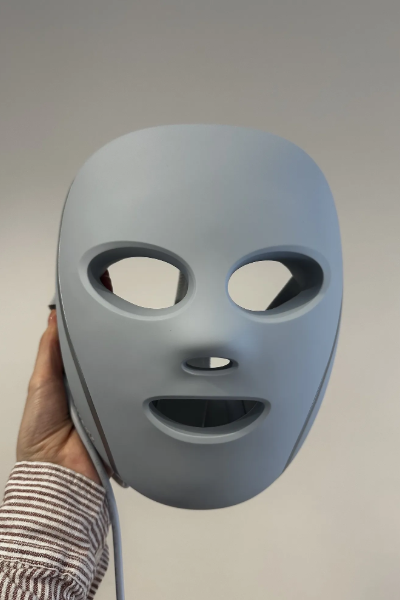

This mask from Omnilux is designed to fit the user's face better than most of the other options on the market. It straps on across the back of your head for a snug fit that will feel comfortable while you wear it for each of the weekly 10-minute treatments. It's made from flexible silicone, and it uses red and near-infrared light to target fine lines and wrinkles as well as calm redness.
FDA-Cleared: Yes
Light Modes: Red and near-infrared
Usage: 10 minutes, 3-5 uses per week
What I Love: Comes with a head strap for comfortable wear; professional grade
What I Don't: Needs to be plugged into the outlet during use; Some reviewers found it bulky.
Review For MC: "It takes a lot for me to switch things up, so when I was approached to test out the Omnilux Contour LED Mask, I was intrigued. Could it actually change my life that much? Spoiler alert: Sorta! My skin is already quite smooth, with only a few dark spots here and there, remnants of my high school days when I would pick at my pimples. I used it religiously over the course of two months (even bringing it with me to Tokyo). I saw progress on some of my hyperpigmentation, but it didn't go away entirely. My skin appeared significantly brighter and more bouncy. If this were a Letterbox’d review, I’d give the mask a solid 4 stars out of 5." — Ana Escalante, a Marie Claire tester and Editor at Who What Wear.
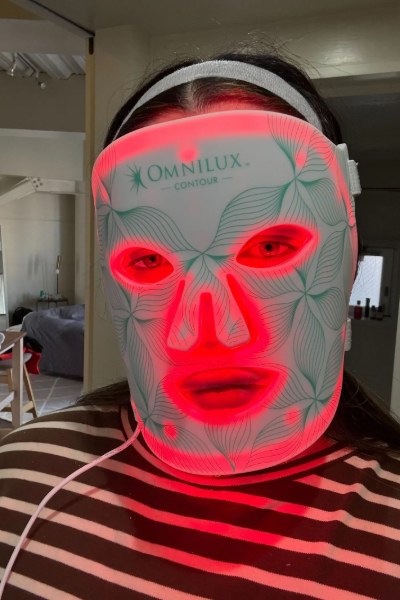

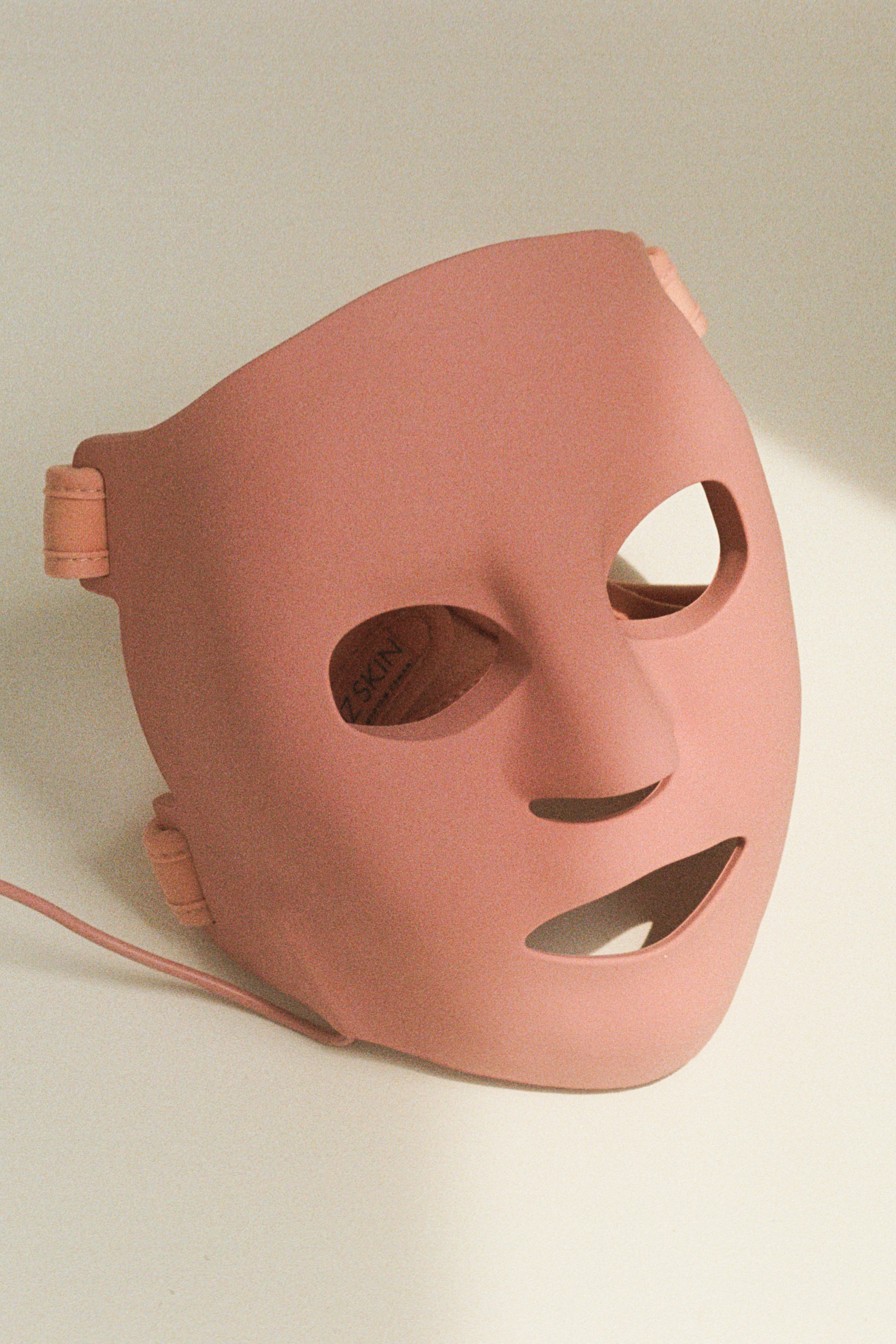
This pink face mask is a supercharged version of its gold predecessor. It’s made from a flexible material that fits your face, has a wireless design, and has two different light combinations for you to use. You can select from a combination of red and infrared light or one that emits red and blue LED light. The former stimulates collagen, calms inflammation, and improves circulation to boost the skin’s luminosity. However, using red and blue lights fights acne by decongesting and balancing the skin over time. The device is FDA-cleared for medical-grade use and comes with four international adaptors, making it perfect for travel.
FDA-Cleared: Yes
Light Modes: Red, blue, and infrared
Usage: 10 minutes, four times per week.
What I Love: Has a variety of lights; wireless; flexible design; comes with international adaptors; medical-grade; calms redness; fights acne
What I Don't: Our reviewer found it heavy to wear.
Review For MC: "I used my MZ Skin mask at least four times a week for ten weeks. While the improvements were gradual, I did see a noticeable overall brightening and a decrease in breakouts. Using the mask takes commitment—it adds at least 10 minutes to my routine. On tired nights, I sometimes use it in the morning instead. However, the mask leaves indentation marks around my eye sockets, so I recommend using it at night if you have plans or need to wear makeup. One major issue is comfort. The molded shape presses uncomfortably into my eyes, and loosening the top strap only helps a little." — Belle Z., a Marie Claire tester.
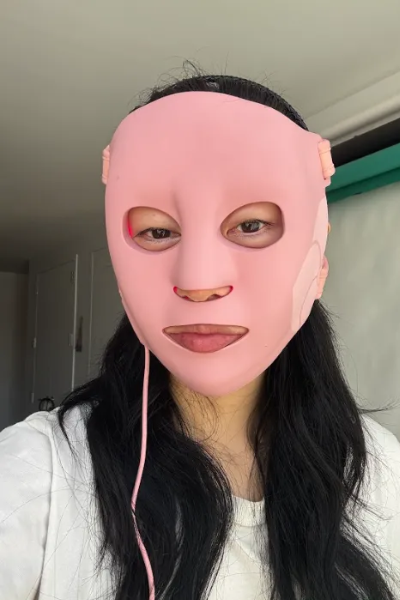

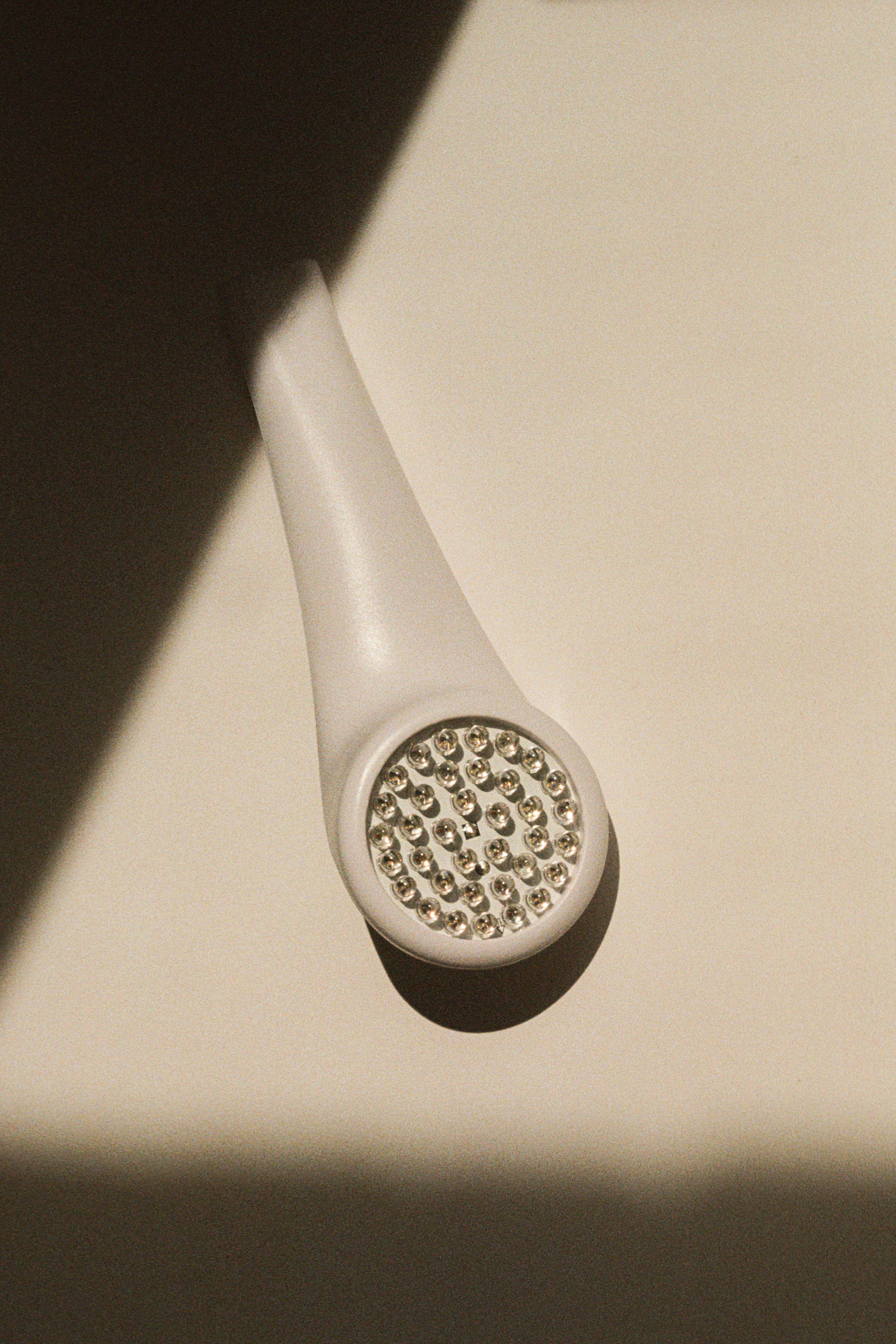
Whenever I sense that a juicy red pimple is going to take up residence on my face, I grab LightStim's handheld LED device. Its small and compact design makes it ideal for targeted treatment. Plus, it leverages blue light, which has been clinically proven to kill acne-causing bacteria, as well as red light, which can be beneficial for reducing inflammation. I promise that using this religiously will significantly reduce the lifespan of your pimple—and prevent new ones from popping up, too.
FDA-Cleared: Yes
Light Modes: Blue, red
Usage: No more than three minutes per area on the face daily
What I Love: Good for acne; targeted treatment; compact shape and size
What I Don't: You have to always hold the device, so not hands-free.
Review For MC: "I tested the Lightstim and noticed a significant reduction in my acne breakouts. It didn’t completely eliminate my acne, but it greatly reduced the number of active breakouts (even my esthetician noticed) and sped up the healing process for existing pimples and the dark marks they left behind. I didn’t see a major improvement in my overall skin texture, but that’s likely because I only used the device on areas where I regularly break out. Overall, it was very easy to use. It easily fit into my regular skincare routine and was also easy to travel with. However, it takes a while to use, as each area requires three minutes, and I had multiple spots to cover." — Danielle R., a Marie Claire tester.
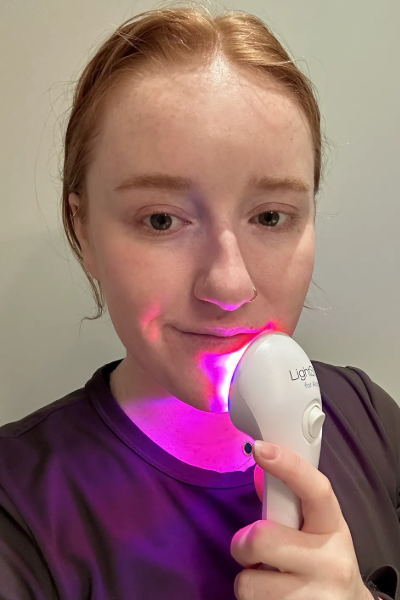
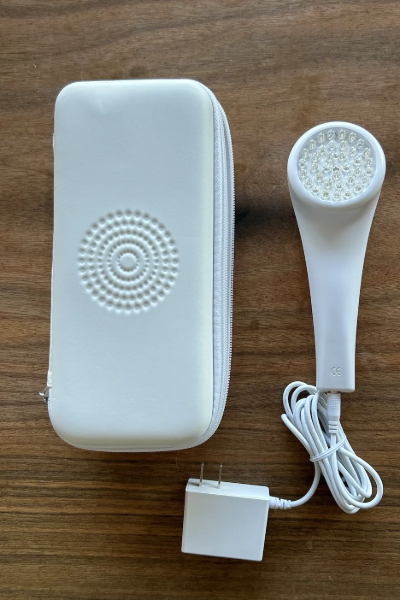
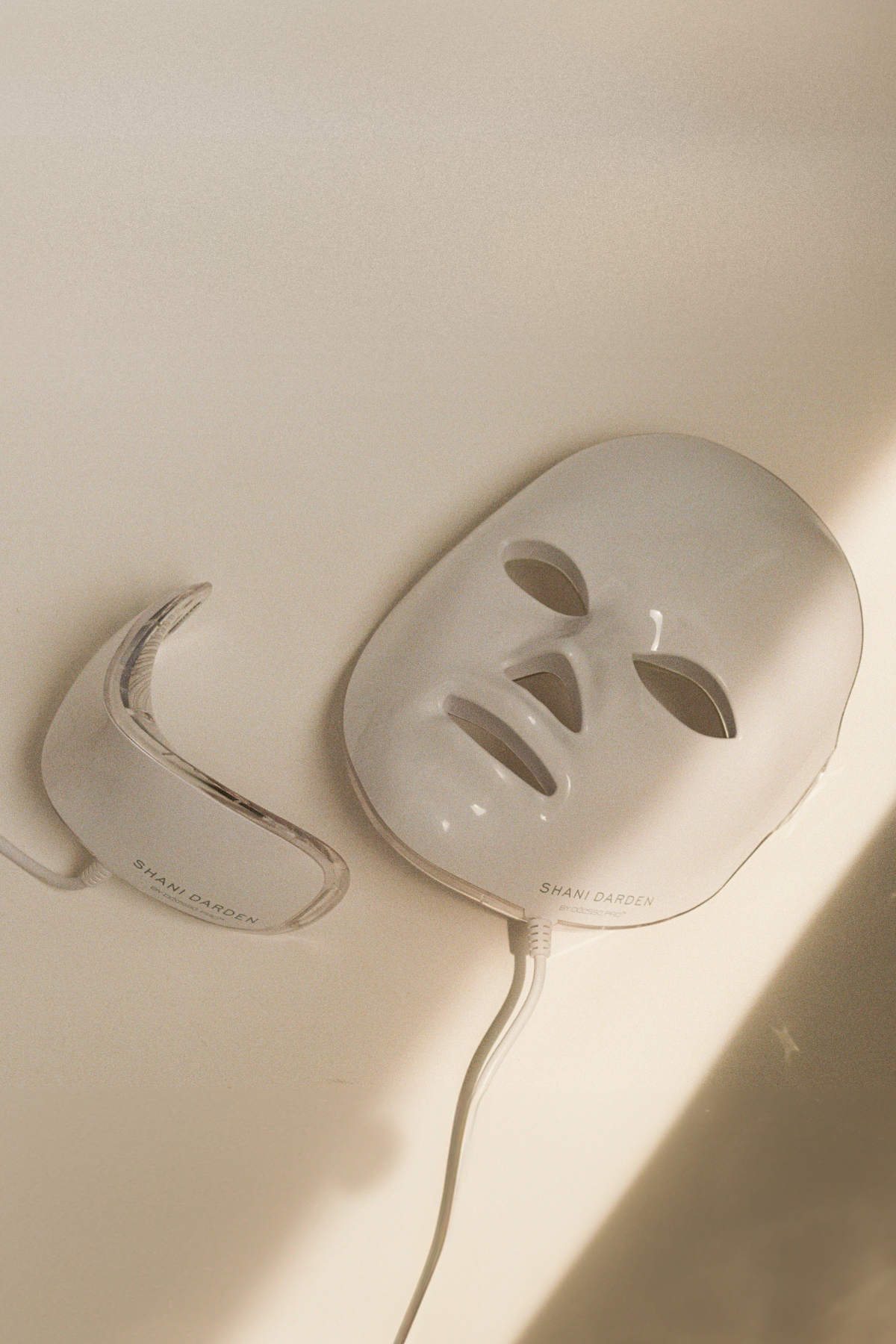
If you want to recreate in-office results at home, and on a regular basis, there’s no better option than this luxe mask by Shani Darden. The blue and red lights target three concerns: signs of premature aging, pigmentation, and acne. To see the best results, you’re going to want to sit with this mask four to five times per week. Editors' favorite part about this product, though, is that it doesn’t just target the face—it has a separate attachment to address your neck.
FDA-Cleared: Yes
Light Modes: Red, near-infrared, blue
Usage: 10 minutes, 4-5 times a week
What I Love: Professional-grade; Customizable; Targets neck
What I Don't: Our tester found it bulky.
Review For MC: "My primary skin concerns are dark spots, hyperpigmentation, redness, and occasional hormonal acne breakouts. I won’t sugarcoat it: This mask is heavy and bulky, so I could only use it while lying down. However, it did help my acne. I used the acne treatment mode about three times a week and the pigmentation mode about once a week throughout the 10-week testing period. I noticed a drastic improvement in my acne. Whenever I had a bad breakout, the mask would smooth and clear it up practically overnight. I’ve heard that your neck is one of the first body parts to show signs of aging, so I appreciate the neck piece that also treats fine lines. Another bonus is that this mask comes with adapters, so you can take it on the go anywhere in the world." — Brooke Knappenberger, Associate E-Commerce Editor
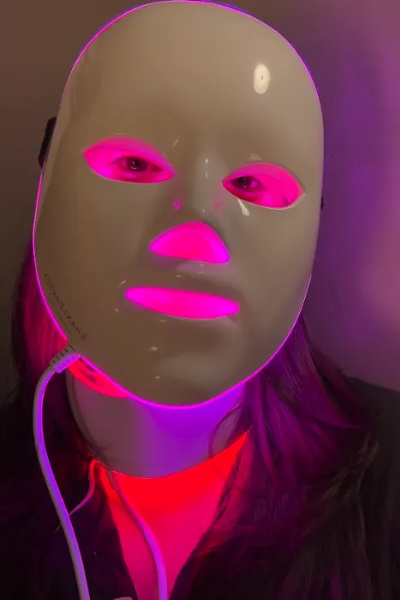
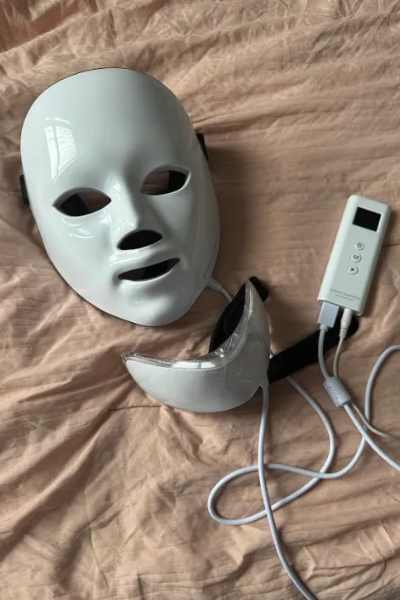
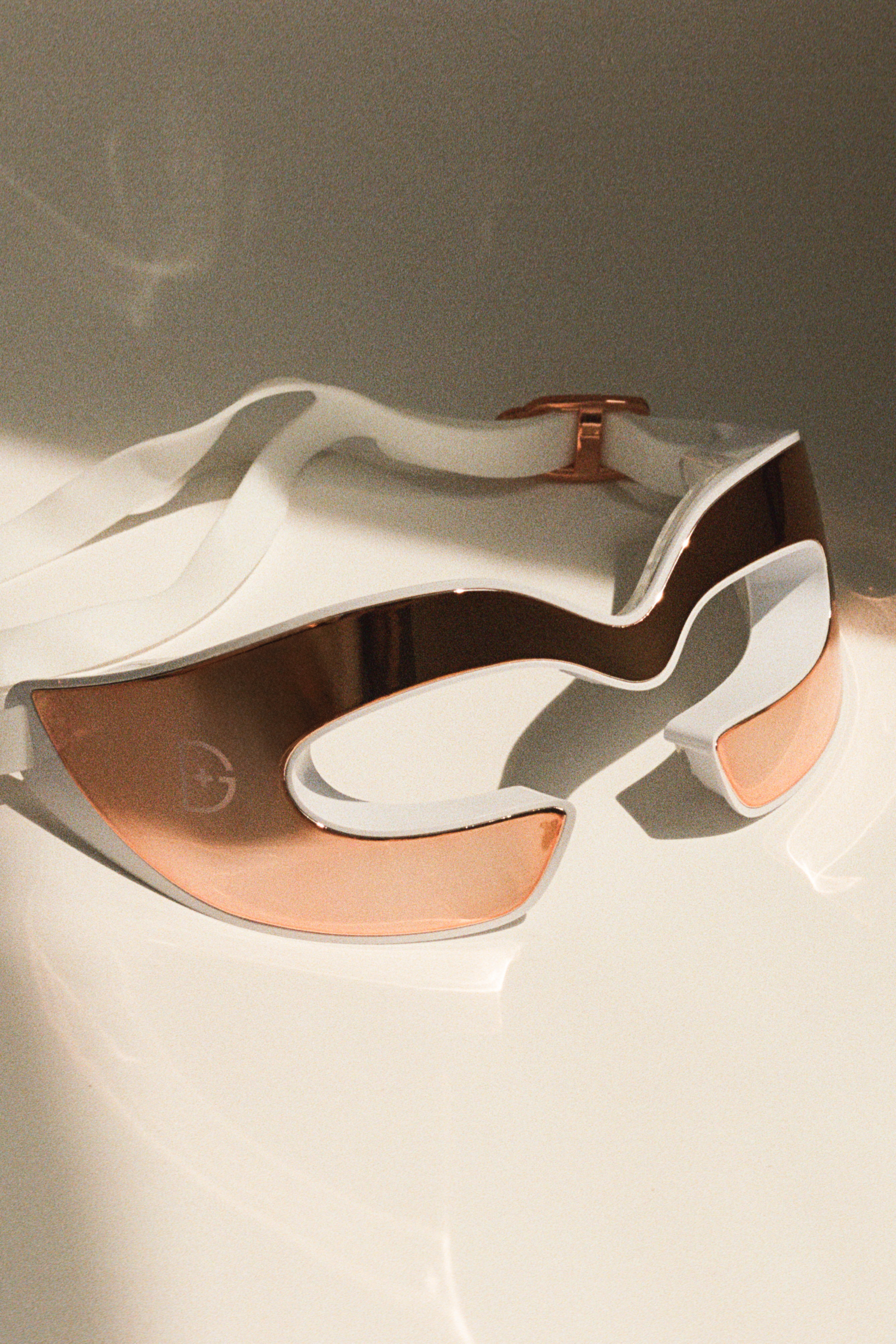
I'm a longtime fan of the Dr. Dennis Gross Skincare DRx SpectraLite FaceWare Pro (peep above), so I was thrilled when the brand launched a device targeted specifically to the eye area. The contraption packs in 96 red LED lights, which means it's able to target the undereye, brow bone, crow's feet, and 11s lines. Like other devices, it's going to help to firm skin and reduce wrinkles. It's unique in that it has the ability to reduce the appearance of dark circles.
FDA-Cleared: Yes
Light Modes: Red
Usage: Three minutes, daily
What I Love: Concentrated treatment; High concentration of lights
What I Don't: Our tester found the strap to be too loose for the perfect fit.
Review For MC: "I used this eye mask every other day for 10 weeks. The mask is lightweight and easy to incorporate into my evening routine, but the strap didn’t tighten enough to stay securely on my head, so I had to keep adjusting it. The built-in 3-minute timer was a nice touch, eliminating the guesswork from each session. I've noticed a subtle change in the fine lines and wrinkles around my eye area during the testing period so far, and I think longer-term testing will likely yield even better results. On the plus side, it’s wireless, charges quickly, and holds its charge well—I only had to plug it in once a week." — Nadiyah B., a Marie Claire tester
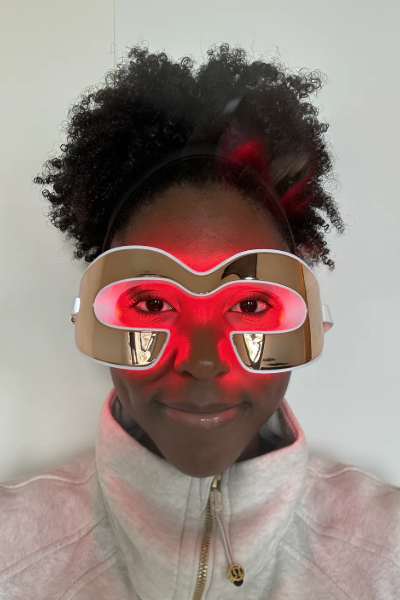
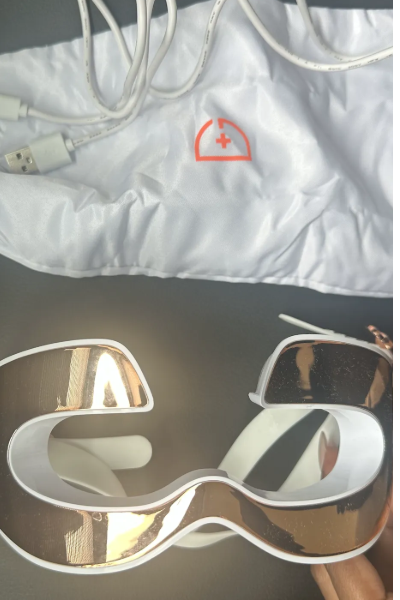
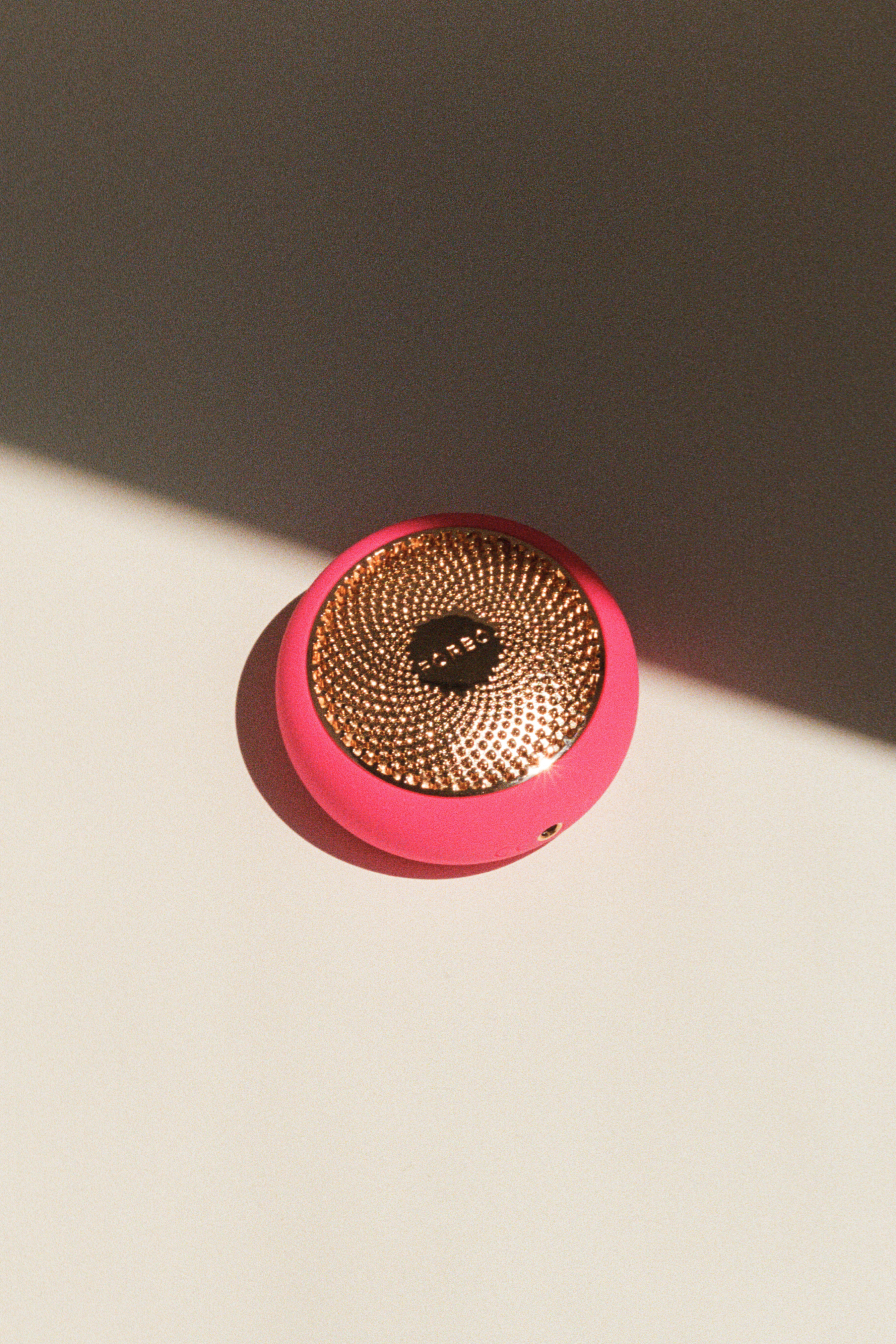
This tiny device is clinically proven to reduce the look of wrinkles in one week. It gently warms and softens the skin to help your products reach the deepest layers of your skin, making them more effective than when used alone. It uses full-spectrum LED light to do this. The accompanying app comes pre-loaded with eight treatments to combat dull, tired-looking skin in just a few minutes. It’s also made from a lightweight, waterproof silicone material and is wireless to use—each charge gives you one hour of use. Each use clocks in at just two minutes.
FDA-Cleared: No
Light Modes: Full-spectrum lights
Usage: The pre-programed treatments last for two minutes, all of which can be found in the complimentary phone app, daily
What I Love: Fast-acting; multiple light options; cordless design; waterproof
What I Don't: Our tester found the FOREO app tricky to use at first.
Review For MC: "I have very sensitive and reactive skin, a decent case of rosacea, and tend to get dry spots around my chin. When I began to play around with this particular device, I relied on its ability to offset any redness around my cheeks and lessen the dryness (and blackheads) on my chin. On days when I woke up with inflamed skin, the tool's red light option provided significant relief. It took some time to get the hang of using the FOREO app, which allows you to essentially customize the device's settings and specify its uses. Still, overall, its battery life lasts better than most, and since the LED mask fits in the palm of my hand, I loved spot treating my cheeks and chin throughout the testing period." — Chelsea A., a Marie Claire tester.

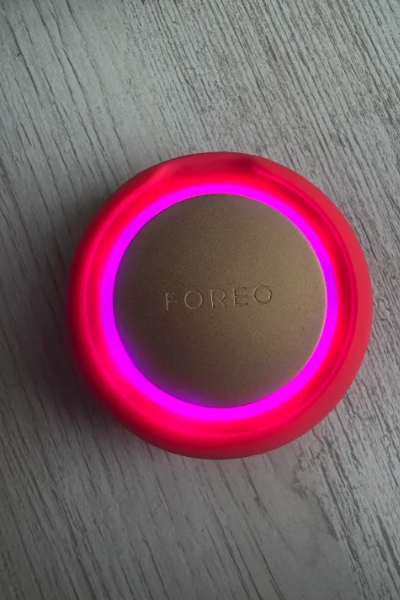

With Carey Mulligan, Kayley Cuoco, and Kristin Davis among this mask's fans, it shouldn't be a shocker that this product delivers big-time results. Part of the efficacy is rooted in its flexible material, which ensures that the red and infrared lights hit and treat every contour of the face. As a result, it's more effective for improving skin tone, texture, and the appearance of fine lines. And because it features 132 powerful LED bulbs, it’s able to treat skin in only 10 minutes. This also has the approval of Dr. Nakra because "it has some of the highest emission (irradiance) in both red and blue wavelengths for a home-based device," he says.
FDA-Cleared: Yes
Light Modes: Red and near-infrared
Usage: 10 minutes, 3-5 times per week
What I Love: Form-fitting; easy to store; powerful; dermatologist-recommended.
What I Don't: Doesn't have lights placed by the upper lip or the upper forehead.
Review For MC: "This works, and it’s 100 percent worth it! Full disclaimer, wearing the mask was a little weird. It’s an odd shape to wrap something flat around your face (I heard they came out with a version that’s rounder!), but once I got the positioning right, I was sold. I noticed a visible difference in the texture and smoothness of my skin, as well as some stubborn dark marks fading away. My skin felt plumper, smoother, and all around more glowy! I don’t get a ton of breakouts, but I can certainly say I was acne-free while using this. The best part—this is super easy to travel with. If you’re someone who’s religious about your routine, the soft nature of this mask makes it super flexible and easy to pack on the go!" — Tonna O, a Marie Claire tester.

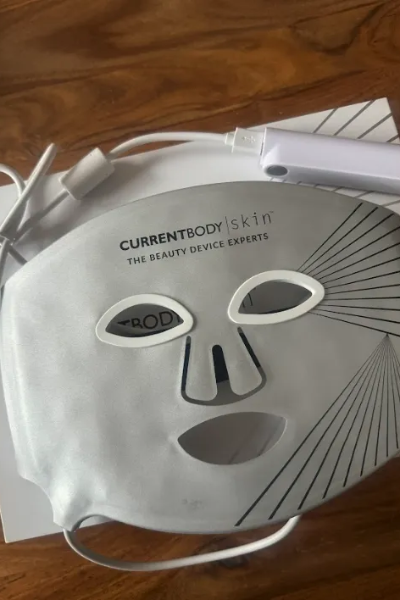
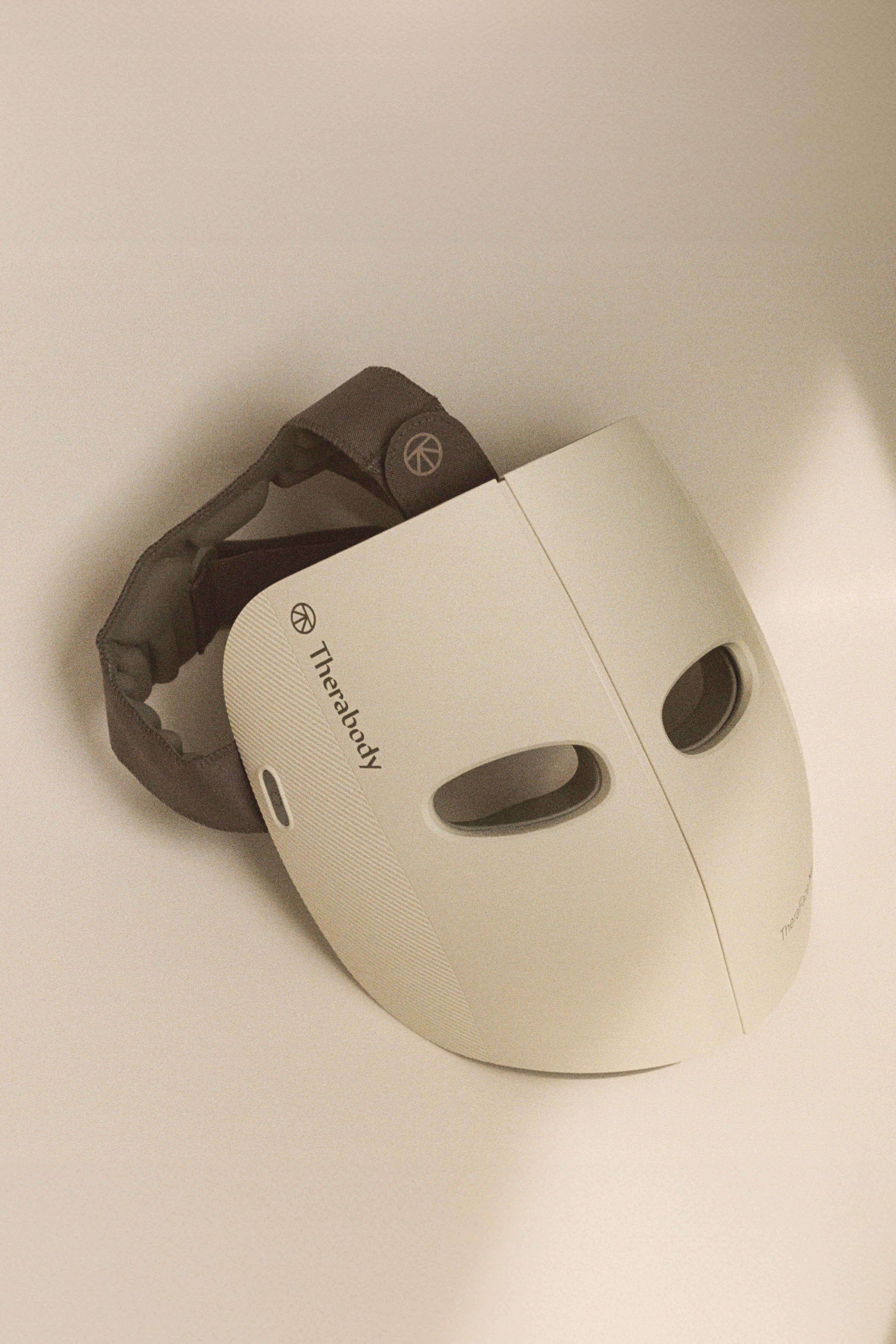
When TheraFace entered the LED face mask category, they did so with their own twist. Taking a cue from the percussive therapy attachment on the famed TheraFace, the brand made a point to incorporate the same vibrational therapy in their 648-light LED mask. Cleared by the FDA, it features red light, infrared light, and blue light to help with hyperpigmentation, acne, and reduce visible signs of premature aging. The brand promises results in just eight weeks, making skincare easier than ever by incorporating removable protective eye shields into its design.
FDA-Cleared: Yes
Light Modes: Red and blue
Usage: Nine minutes, daily
What I Love: Effective; our tester liked the vibrating strap detail
What I Don't: Our tester didn't see a significant reduction in her breakouts over the 10 weeks.
Review For MC: "My mask was easy to use, painless, and gave me some results. I struggle with acne, hyperpigmentation, and uneven skin. As a Black woman, these issues have made me insecure, and I was hoping that the LED mask would be able to reduce their appearance. I tested the mask once a day, every day, for the allotted nine-minute duration, and noticed a change in my hyperpigmentation. I didn’t notice a significant decrease in breakouts. I think I will see a decrease in those conditions with prolonged use. I loved how the straps had a vibration and massage function, which helped me relax after a long day. (This function can be turned off or used solely, which I liked.) The mask also had a long lifespan before charging, and it only took a couple of hours via wired cord to fully charge, which lasted me days." — India Roby, a freelance writer and Marie Claire tester.
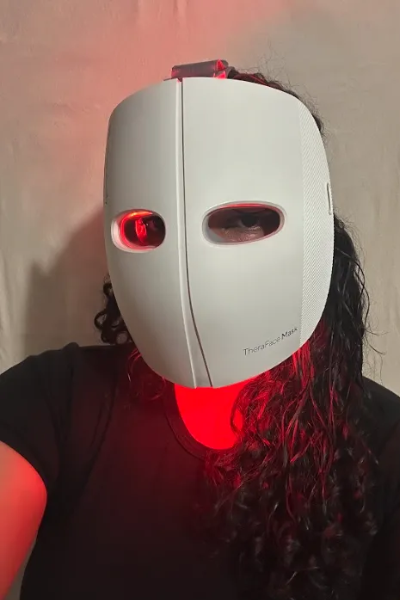

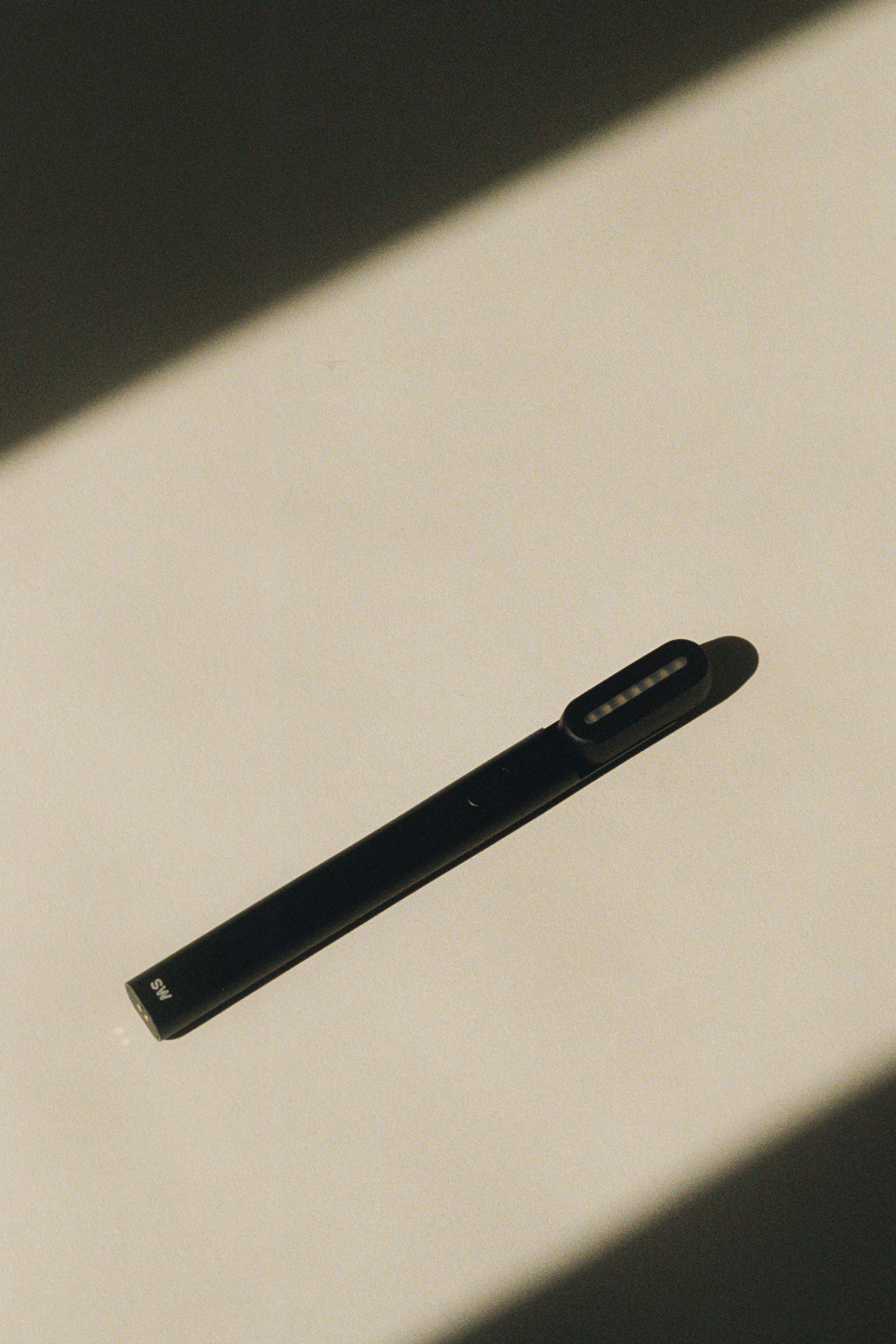
If you’re new to LED therapy, ease into the practice with a handheld device like this multifunctional facial tool from SolaWave. With microcurrent, facial massage, and therapeutic warming functions, this easy-to-use design helps smooth the appearance of blemishes and fine lines with every session. It also minimizes breakouts, decreases puffiness and the appearance of dark circles, and stimulates facial muscles for tighter-looking skin. Bonus: It's portable and super easy to use around the house, on the go, or during travel.
FDA-Cleared: Yes
Light Modes: Red
Usage: No more than three minutes per area of the face, daily
What I Love: Compact; easy to travel with.
What I Don't: Not as powerful; can't multi-task while using because the device requires you to hold it
Review For MC: “The Solawave is a well-designed, compact tool that charges quickly and is easy to travel with— a plus for anyone on the go. It’s straightforward to use, with just one setting. The treatment felt pleasant and soothing on the skin, almost spa-like, but I found it to be a bit time-consuming to use daily. I’ve noticed minor changes in my skin so far, but they’re promising. Overall, the SolaWave device is well-built and convenient to carry, featuring a sleek design and fast charging capabilities.” — Emily L., a Marie Claire tester
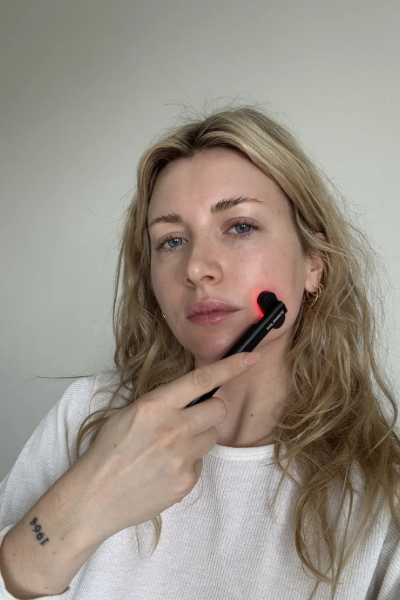
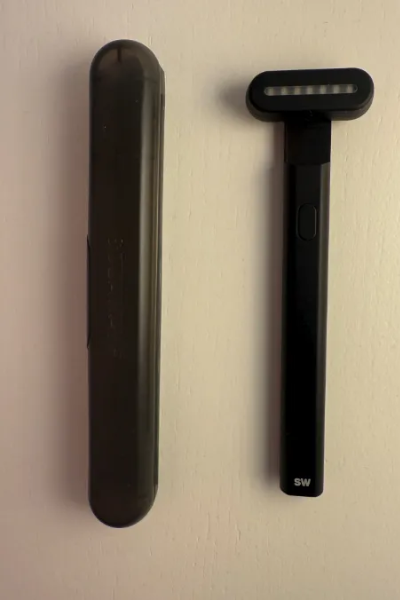
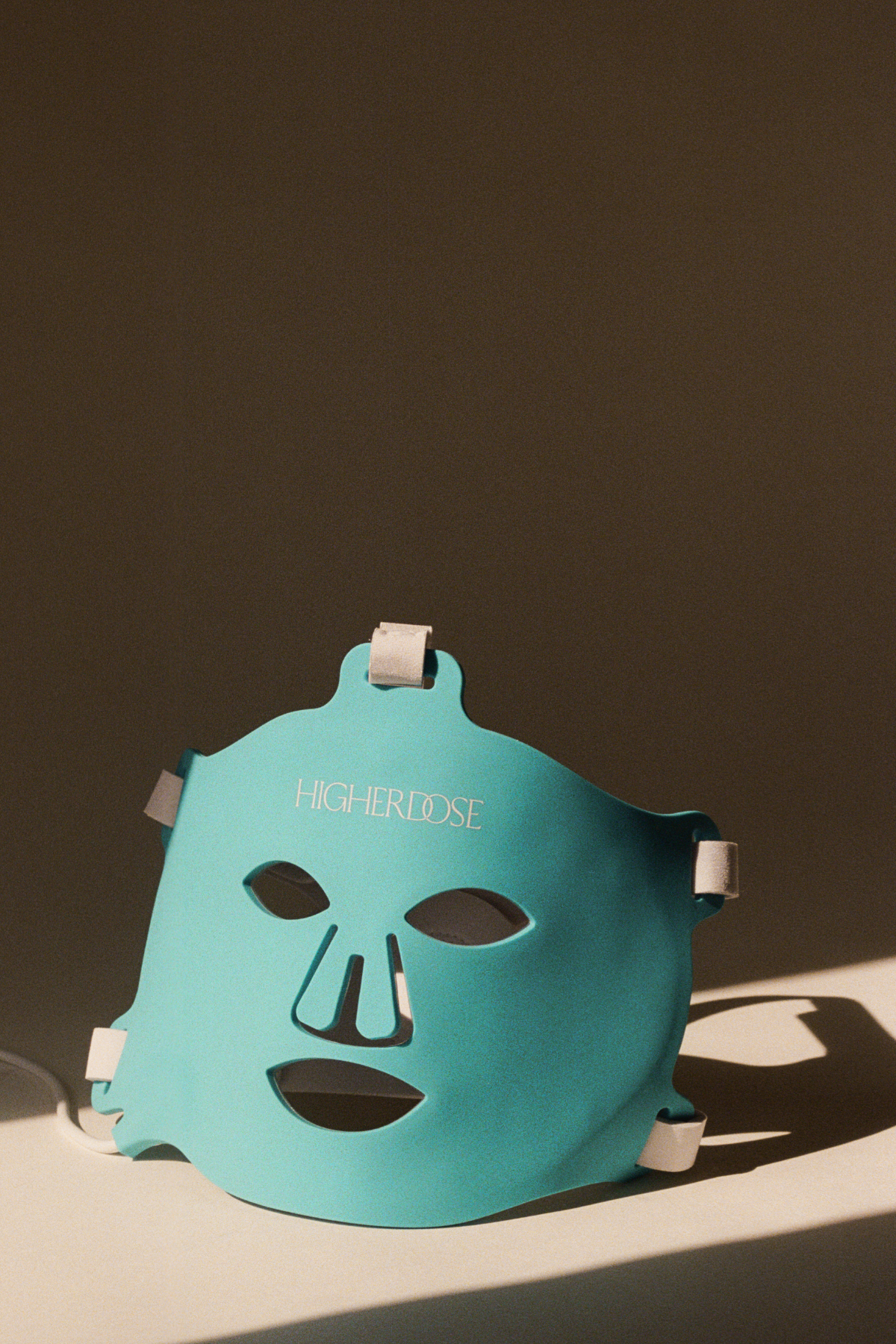
In addition to its popular infrared sauna blanket, HigherDose has a LED face mask in its buzzy lineup. It's crafted from medical-grade silicone with red and near-infrared light-emitting diodes on the interior to mimic low-level rejuvenating wavelengths found in natural sunlight. The result? A relaxing and warming boost to your skin (and mood), that enhances your natural glow. Perhaps the most enticing part here is that the mask, powerful as it may be, doesn't need to be plugged into a wall during use. "We often focus on the face and forget about the neck and decollete," says Gatt of this mask. "This LED Mask takes the hard work on so you don't have to by boosting collagen. elastin and reducing fine lines and wrinkles."
FDA-Cleared: No
Light Modes: Red and near-infrared
Usage: 10 or 20 minutes, 3-5 times a week
What I Love: Comfortable to wear; cordless design; Dermatologist-approved.
What I Don't: Not as powerful as other options on this list; Has only one type of light
Review For MC: "I used the mask 3-5 times a week for the allotted duration. It's comfortable to wear, though it is not enjoyable or easy to walk around in or complete tasks while wearing. I found it quite difficult to see beyond the bright red light!. So, I took the time just to be still. I noticed a boost of brightness after each use, so I look forward to using this tool before special occasions. I have seen very minor changes in my skin's clarity, but I expect those to increase with prolonged use." " — Alex R., a Marie Claire tester
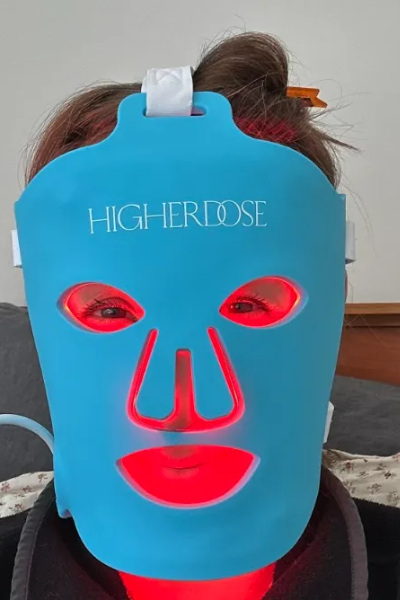
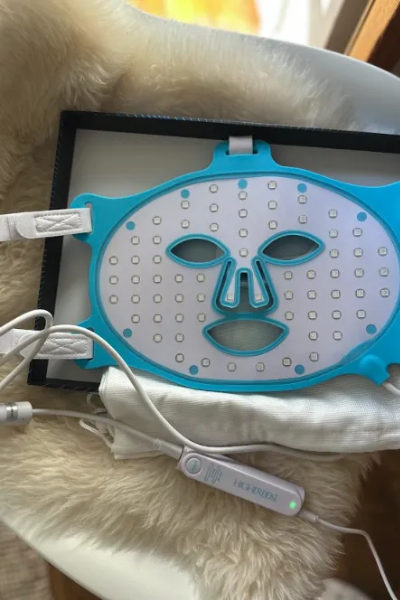
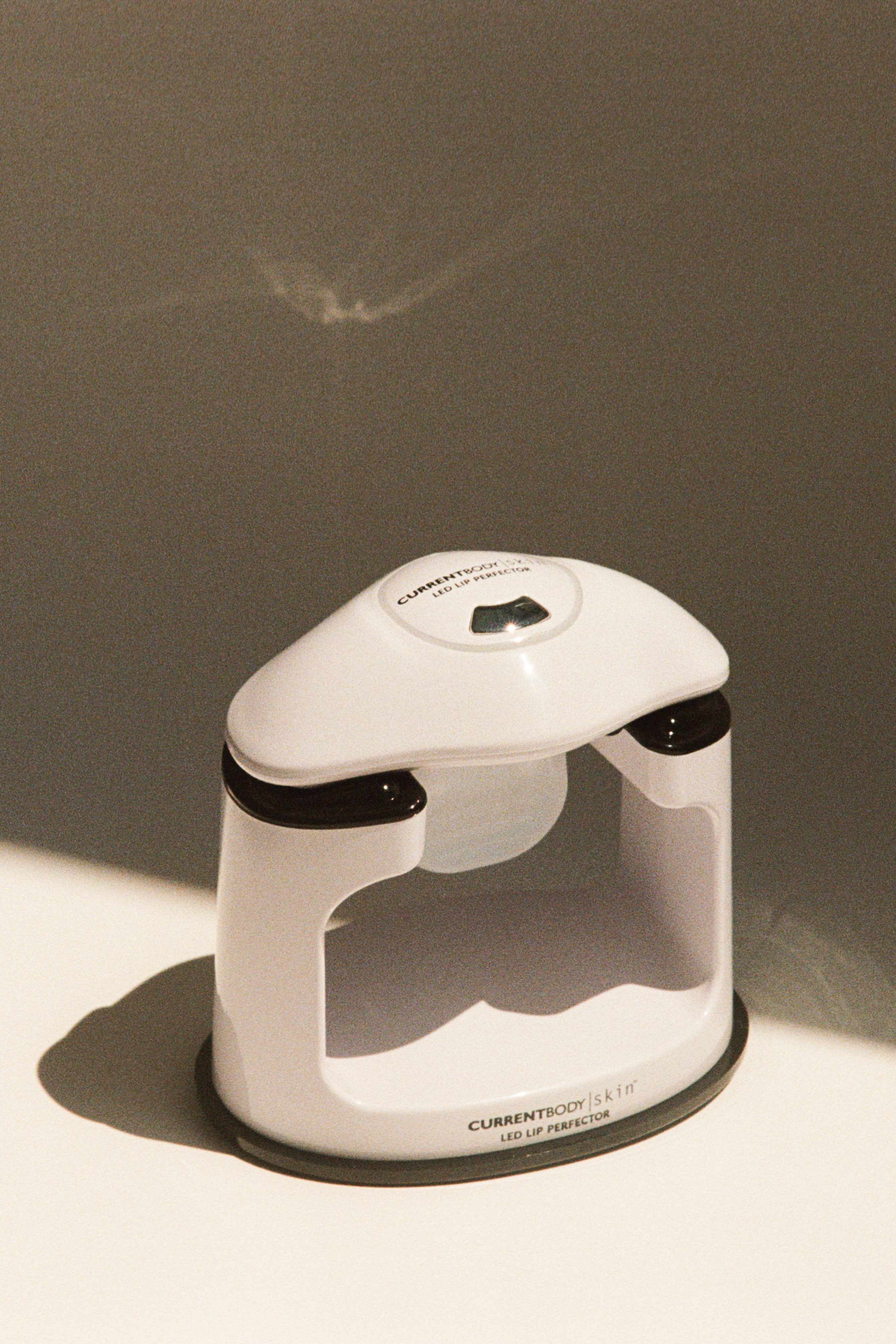
I’ve professed my love for this device in a dedicated review of CurrentBody's LED lip mask, so it’s only natural to include it on Marie Claire's best at-home LED masks list. The small but mighty tool is infused with both red and infrared light therapy to target signs of aging (read: fine lines), plump the lip area, and even tone. While it does take a minimum of four weeks to notice any results, and the full effect doesn’t kick in until eight weeks in, this treatment does work. You just need to make sure to treat the area for three minutes, day in and day out.
FDA-Cleared: Yes
Light Modes: Amber, red, near-infrared
Usage: Three minutes, daily
What I Love: Targeted treatment; easy to store
What I Don't: Some reviewers found it slightly uncomfortable to wear
Review For MC: I've had little lines around my lips for years now. I haven't done filler yet, so I'll try anything. I wouldn't say this made a crazy difference on the skin above my lips, but I do think it smoothed out the texture. I notice that everything looks a little plumper when I put my lipstick on. — Mindy H., a Marie Claire tester.
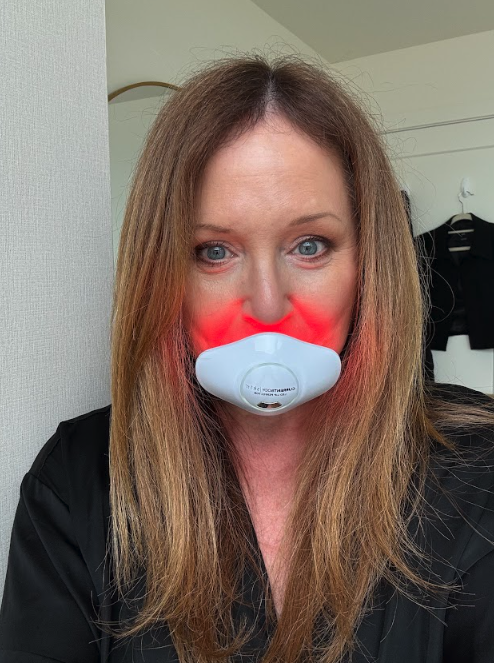
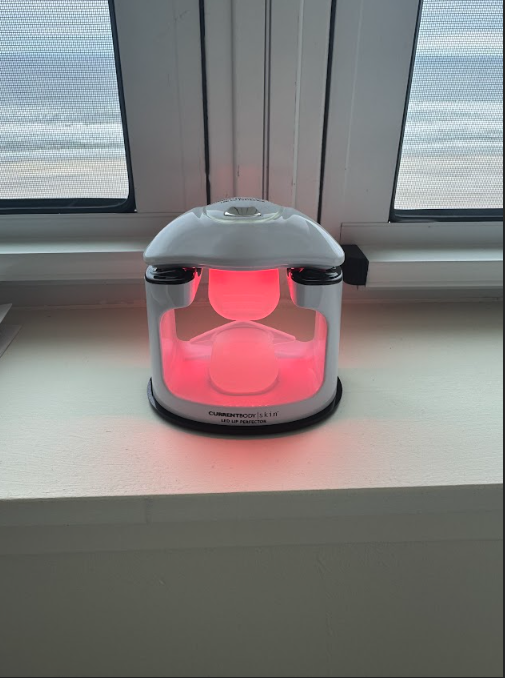

While a large and sturdy LED mask has its benefits, you may not want to deal with such a bulky tool if you're short on space. That's where this flexible one comes into play. Not only does it lay nice and flat for storage purposes, but it also has the added benefit of adhering snugly to the skin. It features red and infrared light, which work together to powerfully improve blood circulation, treat damaged skin, and combat signs of aging.
FDA-Cleared: Yes
Light Modes: Red and near-infrared
Usage: 10 minutes, 3-5 times per week
What I Love: Compact; reviewers found it comfortable to wear
What I Don't: Needs to be plugged into the wall
Review For MC: "I'm pretty confident the only thing that kept my skin from having a full-on eczema and rosacea meltdown during my busy awards season schedule was this mask. It kept my skin calm, and I noticed my complexion looking brighter and even-toned over the weeks, despite my hectic schedule and not sticking to my usual skincare routine. I typically used it in the evenings. On the nights when I did use it, it felt like I was sleeping a bit more deeply than the nights I didn't, which was a lovely added bonus. It's compact and comes in a carrying case that's handy to toss in my suitcases and use on the go. Overall, I'd still recommend it—in fact, I literally did, to a friend who was getting married but was constantly traveling internationally in the weeks leading up to it, complaining about jet lag and dull skin. She was, in fact, glowing on her big day." — Neha Prakash, Entertainment Director
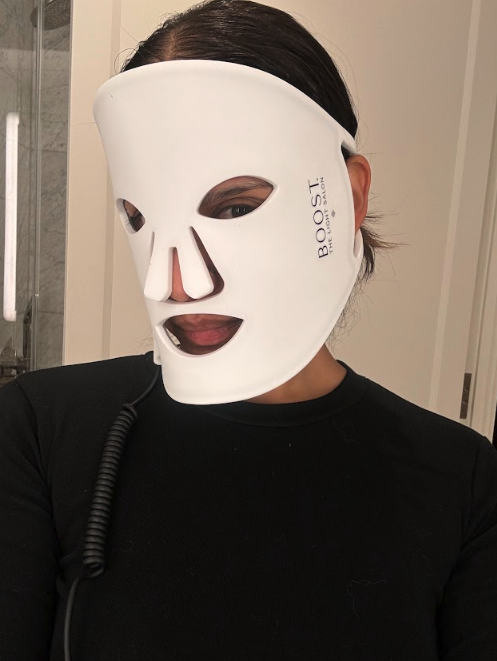
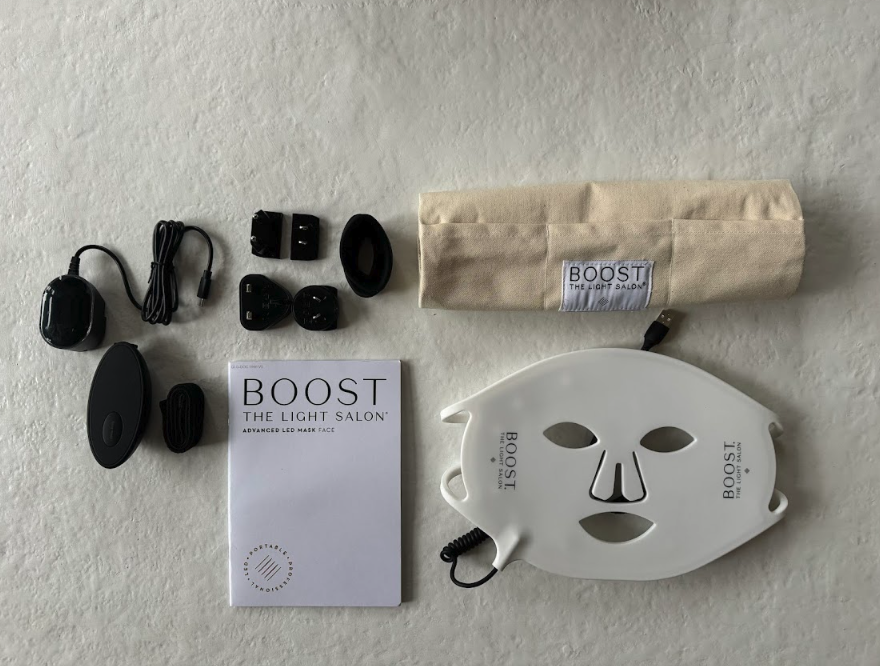
How We Chose The Best LED Light Face Masks
Every at-home LED mask on this list has been specifically chosen by Marie Claire's Beauty Director, Hannah Baxter, and Senior Beauty Editor, Samantha Holender. Every device leverages LED technology that is clinically proven to deliver results, feels comfortable when being worn, and is highly rated by reviewers. While the *best* at-home LED light therapy mask for you will depend on your specific skin concerns, personal preference, budget, and skin goals, you’ll be able to find an option that delivers, ahead. For a more personalized recommendation or if you have any concerns, check with your board-certified dermatologist.
What to Look For in an LED Mask
- Efficacy: Big LED machines in spas and dermatologists' offices are obviously a lot more powerful than little at-home masks. You're going to need a certain level of LED light exposure to see results with your personal tools; the standard minimum emission for red light exposure is 30 milliwatts/cm; blue light will be a bit lower. "For an LED mask to be effective, it must be at a clinically relevant wavelength, and have a reasonable amount of irradiance or power," explains Dr. Nakra. These numbers should be available through the manufacturer or on the product page—below, we dive into what to look for for each color.
- Types of LED Colors Offered: Every color of light corresponds with a specific wavelength that directly correlates with specific results. Red and blue lights typically treat hyperpigmentation, visible signs of aging, and acne. Yellow lights can address redness and rosacea while increasing circulation. For repairing slight skin abrasions, white wavelengths are the best option. Make sure you reference these ranges before you commit to a mask, Gatt advises. "If the device you’re looking at lists a different nanometer that’s not in range, or mentions a different color, it’s not going to help you achieve your skin goals." She explains that blue light should fall within 445 to 490 nm, green light should fall within 490 to 570 nm, yellow light should fall within 570 to 590 nm, red light should fall within 620 to 780 nm, and white light should fall within 700 to 1000 nm.
- FDA Approval: While there are dozens and dozens of LED light therapy face masks to choose from, only a handful have FDA approval. "The search for a safe and effective device begins with making sure the device is FDA approved," says Dr. Nakra. You can check this for yourself on the FDA's database.
- Design: While you might prefer an LED mask that goes on like a pair of sunglasses, others might want a design that straps them in—it's really personal preference. That said, some features are non-negotiable, like the number of LED lights and their distribution. The more LED lights, Gatt says, the better. "In order for the lights to penetrate directly into the cells, they need to be close together and there needs to be a lot of lights, at least 100 or more," she continues. "You also want the lights as close together as possible to get the best results."
- Comfort: The most comfortable at-home LED for you largely comes down to personal preference. Because they are heavier devices, chances are they are going to feel a little weighted—it just depends where that weight is distributed. A rubber or silicone option will rub the skin less, a sunglass-inspired mask will likely cause a little ear irritation, and a behind-the-head strap will require you to sit still.
Is LED Light Therapy Safe?
After years of avoiding the sun's UV rays in service of healthy skin, treating your face with light can feel counter-intuitive. But facialists, dermatologists, beauty editors, and the American Academy of Dermatology all agree: Generally speaking, LED light therapy treatments are safe and effective, since they don't use UV rays.
A couple of caveats, however: You should be careful about using LED face masks alongside skincare that makes your face sensitive to light, like retinol or Accutane. "Prescription drugs, including antibiotics, diuretics, and even some over-the-counter medications such as St. John’s Wort can cause sensitivity to LED light therapy," explains Dr. Nakra. "Rare eye conditions including certain retinal diseases can be exacerbated by LEDs as well. If you are unsure, check with your doctor or dermatologist about whether your medication can cause light sensitivity (photosensitivity)."
You'll also want to exercise extra caution when it comes to blue light. "Using it longer than 20 minutes can cause pigmentation to worsen or appear," says Gatt.
The Benefits of LED Light Therapy
At-home LED therapy devices are less powerful than the treatments you'd get at a dermatologist's office, which means you can use them safely, but it'll take longer to see visible results. The result you'll see, however, depends largely on the type of light therapy you're using. Most of the LED face masks on our list use either red (anti aging) or blue light therapy (anti-bacterial) to treat several skin woes. Still, there are also different wavelengths—including white, yellow, amber, and green—that might be featured in your product. "Combining more than one wavelength helps you get the best results," says Gatt. "Your skin is always changing, so it’s nice to have options."
Ahead, find detailed breakdowns of the benefits of the most LED light therapy colors with insight from Dr. Nakra.
- Benefits of Red LED Light Therapy: Red light is going to be the most popular color you'll find in LED masks, in part because its benefits are so wide-ranging. "Red LED lights emit energy that travels deep into the skin, and stimulates the molecular pathways inside the cells and mitochondria to produce more collagen, reduce inflammation, and reduce redness," explains Dr. Nakra. Red light has also been shown to increase collagen production in the skin, which helps reduce the appearance of fine lines and wrinkles.
- Benefits of Blue LED Light Therapy: Unlike red light therapy, blue light therapy works better for acne-prone skin. It reduces the frequency of new breakouts and treats existing ones, courtesy of a two-step process within the layers of your skin. First, blue light can make your skin produce less oil, which equals less clogged pores. Then comes step two: The destruction of bacteria. "Blue light has a shorter wavelength, and thus reaches only the superficial layers of the skin," explains Dr. Nakra. "The benefits include treatment for acute inflammatory conditions like acne and hyperpigmentation."
- Benefits of Green LED Light Therapy: The opposite of red on the color wheel? Green, which is why green light therapy is a saving grace for anyone with unwanted redness or rosacea. "Green LED light penetrates into the intermediate layers of the skin and is absorbed preferentially by minute blood vessels that can cause facial redness and rosacea," says Dr. Nakra. The result? A more even skin tone. Gatt adds that green light "targets dark circles and pigmentation" by preventing excess melanin from being produced.
- Benefits of Yellow LED Light Therapy: The benefits of yellow light are somewhat similar to those of green light. While you typically won't find a device with exclusively yellow light therapy, it may be one of your options. "Yellow LED light penetrates into the superficial layers of the skin," explains Dr. Nakra. Gatt adds that by doing this, it's able to stimulate blood flow and reduce redness, rosacea, and the appearance of broken capillaries. Yellow LED light can also be referred to as amber LED light, for reference.
- Benefits of White LED Light Therapy: "White LED light contains all visible wavelengths and can be beneficial in treating some types of depression—especially seasonal affective disorder," says Dr. Nakra. "When used in the mornings, white LED light treatments can also help enhance wakefulness and regulate normal circadian rhythms." That's not all though. Gatt explains that it also comes along with tightening benefits and reduced inflammation.
How to Use an LED Light Therapy Mask
You can use LED light therapy masks either in the morning or at night, depending on the results you’re hoping to achieve. Using an LED mask in the morning, for instance, can give your skin a glow before you start your day.
However, using a LED device at night will “calm down skin inflammation resulting from daily exposure to skin irritants like pollution, especially in people with sensitive and rosacea-prone skin," she says.
Regardless of when you decide to wear your device, remember that consistency is key if you want to see results. Every brand has different directives on how often to use your mask, so be sure to check the label to make sure you're using it correctly. Generally, you can use the face mask of your choice roughly three to five times a week for around 10 minutes.
How Long Does it Take to See Results From LED Therapy?
Like most skincare solutions, it will take some time before you see the substantial long-term effects of using an LED light therapy mask at home. Most masks promise results after weeks of consistent use, but the exact number of time varies from device to device.
Why Trust Marie Claire
For more than 30 years, Marie Claire has been an internationally recognized destination for news, fashion, and beauty trends, investigative packages, and more. When it comes to the products Marie Claire recommends, we take your faith in us seriously. Every product that we feature comes personally recommended by a Marie Claire writer or editor, or by an expert we’ve spoken to firsthand.
We also consulted two experts for their insights to help you find the best and safest at-home LED light therapy mask recommendations online. They include one Esthetician, one double-board-certified facial and ophthalmic plastic surgeon, alongside our team of makeup-savvy editors who try and test the best new beauty launches in every category.
How We Tested
After chatting with our experts and doing our own independent research, we selected 14 at-home red light therapy masks to test. Our independent testers (plus four Marie Claire editors) then reviewed their masks based on their comfort, efficacy, and whether or not they met the claims each device set. They tested each device according to the brand's directions and shared their feedback with us on a bi-weekly basis for 10 weeks of testing to compile this list.
Meet the Experts

Tanuj Nakra, MD, FACS is a double board-certified facial & ophthalmic plastic surgeon who has practiced at TOC since 2008. He was born in London, England, and raised in St. Louis. He completed residency and fellowship training at UCLA. After his medical training, Dr. Nakra served on the UCLA faculty and established private practices in both Beverly Hills and Santa Barbara before moving to Austin. He has been consistently recognized as a Top Doctor by Austin Monthly, Texas Monthly, Castle Connolly, and Who’s Who in Medicine for over the past decade. Dr. Nakra serves as Clinical Faculty at the Dell Medical School at UT-Austin, and is the Fellowship Director of an accredited American Academy of Cosmetic Surgery (AACS) Fellowship. He has been an invited keynote speaker at major conferences around the world, training other surgeons in the latest techniques, including his own signature cosmetic procedures. Dr. Nakra has authored over 70 peer-reviewed scientific articles and has had numerous grant-supported research projects in the field of reconstructive and cosmetic surgery. He has served on the Executive Committee of the American Board of Facial Cosmetic Surgery, and the Board of Directors of the Cosmetic Surgery Foundation, as well as the President of the Austin Ophthalmology Society. With his scientific expertise in facial aesthetics, he co-founded AVYA Skincare, a medical-grade Ayurvedic skincare brand. He also recently co-founded Global Cosmetic Surgery, an international medical educational platform.

Skin health guru Erica’s decade’s worth of experience working as an esthetician and makeup artist has shaped her foolproof, fuss-free beauty philosophy. She believes that curating thoughtful, streamlined skincare regimens for her clients is key to achieving effortless natural beauty and an overarching sense of empowerment, confidence and well-being. As someone who loves the outdoors and being active, Erica recognizes the link between health, wellness and beauty and embraces a holistic approach that puts equal emphasis on both an inner and outer glow. Erica honed her talent and channeled her passion under the tutelage of celebrated Los Angeles esthetician Gina Mari after having spent years as a makeup artist. Acknowledging that the optimal canvas for makeup is clear, toxin-free skin, Erica gained invaluable experience working on a myriad of skin types with a range of needs, while learning from the industry’s top beauty mavens. In 2019, Erica launched her business EM SKIN, bringing a Beverly Hills medical spa sensibility to the South Bay where clients can always expect highly bespoke, transformational treatments that cleanse, hydrate, detox and sculpt using state of the art machines, the latest technologies, and medical and science-based products. Stepping into her intimate, beach-meets-chic studio is an experience that is simultaneously spirit lifting, skin firming, and anti-aging. Erica offers a tranquil retreat in the heart of Hermosa beach that calms both the mind and the skin, while delivering game-changing results far glowier than any filter can produce.
Get exclusive access to fashion and beauty trends, hot-off-the-press celebrity news, and more.
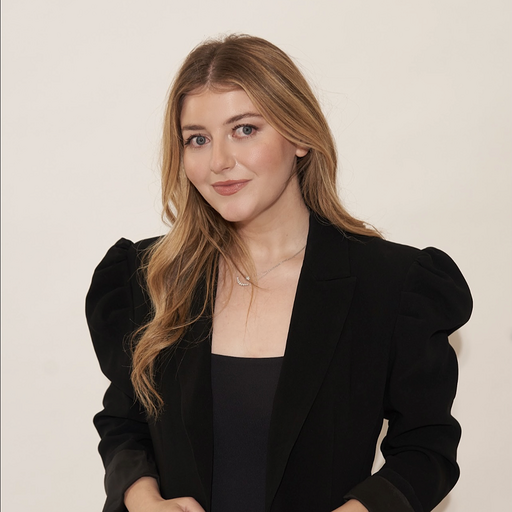
Samantha Holender is the Senior Beauty Editor at Marie Claire, where she reports on the best new launches, dives into the science behind skincare, and shares the breakdown on the latest and greatest trends in the beauty space. She's studied up on every ingredient you'll find on INCI list and is constantly in search of the world's glowiest makeup products. She's constantly tracking the biggest nail and hair trends to pop up in the beauty space, going backstage during fashion weeks, tracking celebrity looks, and constantly talking to celebrity hair stylists, nail artists, and makeup artists. Prior to joining the team, she worked as Us Weekly’s Beauty and Style Editor, where she stayed on the pulse of pop culture and broke down celebrity beauty routines, hair transformations, and red carpet looks. Her words have also appeared on Popsugar, Makeup.com, Skincare.com, Delish.com, and Philadelphia Wedding. Samantha also serves as a board member for the American Society of Magazine Editors (ASME). She first joined the organization in 2018, when she worked as an editorial intern at Food Network Magazine and Pioneer Woman Magazine. Samantha has a degree in Journalism and Mass Communications from The George Washington University’s School of Media and Public Affairs. While at GWU, she was a founding member of the school’s HerCampus chapter and served as its President for four years. When she’s not deep in the beauty closet or swatching eyeshadows, you can find her obsessing over Real Housewives and all things Bravo. Keep up with her on Instagram @samholender.
- Julia MarzovillaFashion E-Commerce Editor